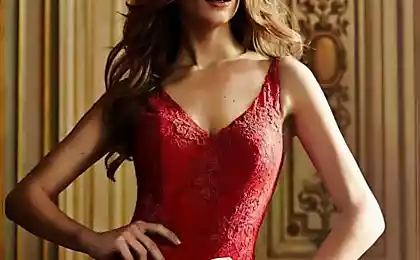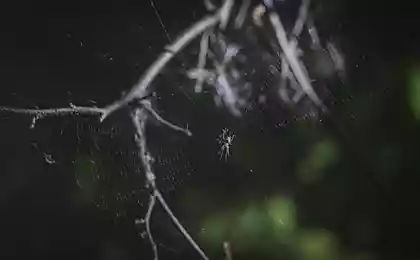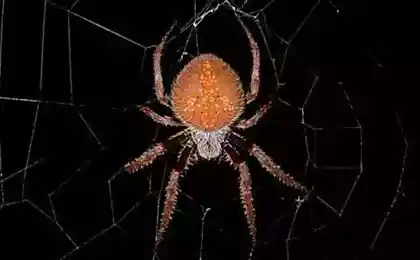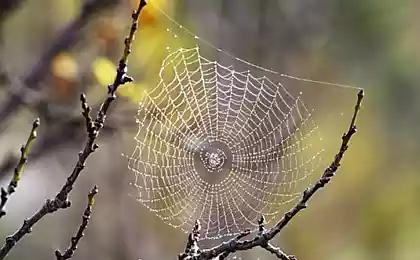819
How do spiders make webs
Spiders create webs, lowering the acidity in the solution with spider protein.

The web has long intrigued researchers for their unique characteristics: when the extraordinary extensibility and lightness, she is also extraordinarily strong. If you compare the spider thread with a steel wire of the same diameter, they will withstand about the same weight. But the web is six times lighter, and therefore six times stronger. But perhaps the biggest mystery is how spiders do it. It is known that the web consists of proteins called spidroins originally located in the solution, and then somehow turn into a solid thread. The transformation occurs again in an aqueous solution (i.e. protein is not dehydrated), at normal temperature and that is pretty fast. What makes spider dissolved proteins become solid and flexible filament?
Spidroin – proteins are quite large, consisting on average of 3 500 amino acids, for the most part organized in a repeating sequence. The most important for creating the web threads are amino acids at the ends of the polypeptide chain, and different spiders limit of a sequence of spidroin similar to each other. Forming a thread, the protein molecules change the spatial structure. This occurs under the influence of the pH gradient in the silk glands of spiders in one of their end of the acidity is higher than in the other, and at some point drop in pH causes spidroin to buy rugged styling.
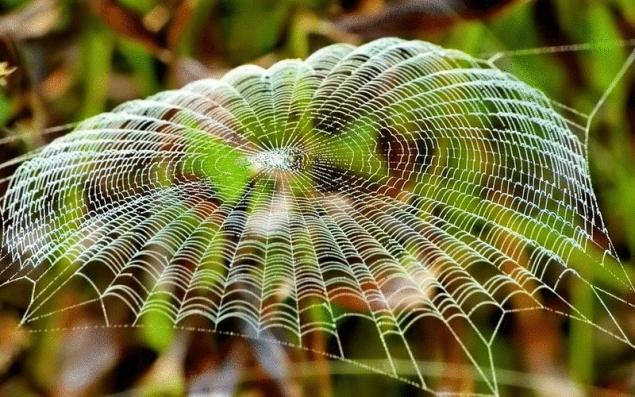
The details of the process have tried to find out Marlene Andersson (Marlene Andersson) and her colleagues from the Institute of agricultural Sciences in Uppsala and the Karolinska Institute. Using microelectrodes, they accurately measured the acidity in spider glands and found that the pH gradient steeper than expected from neutral (pH=7,6) in the depth of the gland to fairly acidic (pH=5,7) in the excretory duct. At the same time found out that in the web camera closer to the exit increases the concentration of bicarbonate ions (carbonic acid residues) and the amount of CO2. The researchers came to the conclusion that the difference in acidity is created through the enzyme carbonic anhydrase, which, from carbon dioxide and water makes carbonic acid, which, in turn, exists in solution as the bicarbonate ions and acidic hydrogen ions H+. Further experiments confirmed the assumption that the carbonic anhydrase as the Creator of the "spider" acid gradient.
In an article in PLoS Biology, the authors write that the acidity of the medium have a different impact on different parts of the molecules spidroin. If one of the ends of the polypeptide chain (N-end) in an acidic environment. with other N-ends spironolac other molecules, and the higher the acidity (lower pH), the stable was the structure of the N-end, the other end of the protein (C-Terminus), in contrast, were losing stability with decreasing pH and were left without any feature of the structure until the last moment, when the protein has adopted final "spider" structure. That is, different parts of the same molecule change the chemical environment acted differently.
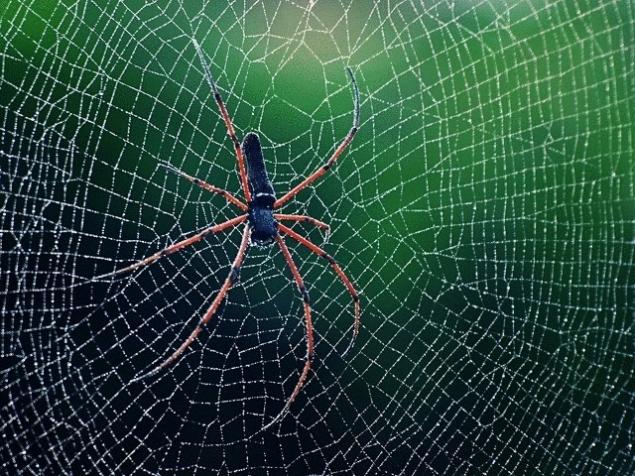
But that's not all – the C-terminal end of the spider spidroins, as it turned out, similar to amyloid proteins, which form protein deposits in nerve cells in neurodegenerative diseases (Alzheimer's, for example). Amyloid proteins form polymeric complexes in the form of long filaments, strands deposited in the nervous tissue. Obviously, in the case of the web the mechanism of the similarities: the flat end of spidroin need to protein molecules quickly coalesced into the thread. And in the "spider" structure With the end switches abruptly when the acidity of the medium reaches a pH of 5.5, up to this point he recall, remains unstructured and unformed.
However, if molecules spidroins stuck together as they please, the spider thread did not work. To each molecule knew its place, there is N-end, which increases the acidity stabiliziruemost stronger and stronger holds for the neighboring molecules. Due to the N-Terminus squirrels know their place in the emerging threads of a web, not yet having hardened, it becomes structured. Well, the binding "cement" in the end is With the end. Engineers have long wanted to do laboratory web; it is possible that new information about the silk proteins to help them in this.
Source: nkj.ru

The web has long intrigued researchers for their unique characteristics: when the extraordinary extensibility and lightness, she is also extraordinarily strong. If you compare the spider thread with a steel wire of the same diameter, they will withstand about the same weight. But the web is six times lighter, and therefore six times stronger. But perhaps the biggest mystery is how spiders do it. It is known that the web consists of proteins called spidroins originally located in the solution, and then somehow turn into a solid thread. The transformation occurs again in an aqueous solution (i.e. protein is not dehydrated), at normal temperature and that is pretty fast. What makes spider dissolved proteins become solid and flexible filament?
Spidroin – proteins are quite large, consisting on average of 3 500 amino acids, for the most part organized in a repeating sequence. The most important for creating the web threads are amino acids at the ends of the polypeptide chain, and different spiders limit of a sequence of spidroin similar to each other. Forming a thread, the protein molecules change the spatial structure. This occurs under the influence of the pH gradient in the silk glands of spiders in one of their end of the acidity is higher than in the other, and at some point drop in pH causes spidroin to buy rugged styling.

The details of the process have tried to find out Marlene Andersson (Marlene Andersson) and her colleagues from the Institute of agricultural Sciences in Uppsala and the Karolinska Institute. Using microelectrodes, they accurately measured the acidity in spider glands and found that the pH gradient steeper than expected from neutral (pH=7,6) in the depth of the gland to fairly acidic (pH=5,7) in the excretory duct. At the same time found out that in the web camera closer to the exit increases the concentration of bicarbonate ions (carbonic acid residues) and the amount of CO2. The researchers came to the conclusion that the difference in acidity is created through the enzyme carbonic anhydrase, which, from carbon dioxide and water makes carbonic acid, which, in turn, exists in solution as the bicarbonate ions and acidic hydrogen ions H+. Further experiments confirmed the assumption that the carbonic anhydrase as the Creator of the "spider" acid gradient.
In an article in PLoS Biology, the authors write that the acidity of the medium have a different impact on different parts of the molecules spidroin. If one of the ends of the polypeptide chain (N-end) in an acidic environment. with other N-ends spironolac other molecules, and the higher the acidity (lower pH), the stable was the structure of the N-end, the other end of the protein (C-Terminus), in contrast, were losing stability with decreasing pH and were left without any feature of the structure until the last moment, when the protein has adopted final "spider" structure. That is, different parts of the same molecule change the chemical environment acted differently.

But that's not all – the C-terminal end of the spider spidroins, as it turned out, similar to amyloid proteins, which form protein deposits in nerve cells in neurodegenerative diseases (Alzheimer's, for example). Amyloid proteins form polymeric complexes in the form of long filaments, strands deposited in the nervous tissue. Obviously, in the case of the web the mechanism of the similarities: the flat end of spidroin need to protein molecules quickly coalesced into the thread. And in the "spider" structure With the end switches abruptly when the acidity of the medium reaches a pH of 5.5, up to this point he recall, remains unstructured and unformed.
However, if molecules spidroins stuck together as they please, the spider thread did not work. To each molecule knew its place, there is N-end, which increases the acidity stabiliziruemost stronger and stronger holds for the neighboring molecules. Due to the N-Terminus squirrels know their place in the emerging threads of a web, not yet having hardened, it becomes structured. Well, the binding "cement" in the end is With the end. Engineers have long wanted to do laboratory web; it is possible that new information about the silk proteins to help them in this.
Source: nkj.ru












